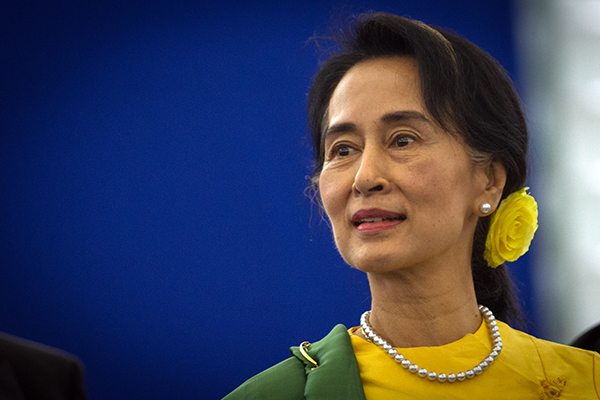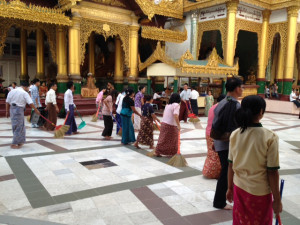
Burmese democracy has evolved rapidly since 2012, and in Aung San Suu Kyi—widely known as “The Lady”—it has a famously female face. Despite this, there are few established affirmative mechanisms for women to participate in political life, and this won’t change in the upcoming elections.
Burma’s bicameral union legislature has the lowest proportion of female representation of any country in Southeast Asia. Affirmative action on gender inequality is not enshrined in the law and women’s representation is low on the reform agenda.
There is no lack of challenges facing Burma’s upcoming elections. The reserved seats for the military, potential disenfranchisement of the Rohingya minority and legal impediments to Aung San Suu Kyi’s presidential candidacy are only some of the reasons these elections are likely to remain fundamentally undemocratic.
It is nonetheless necessary to not lose sight of the vital need for improved women’s representation as part of any reform package intended to further develop democracy in Burma.
Greater representation for the greater good
For elections to be democratic in more than a merely procedural sense, they must be truly representative of their population. Elections on November 8 are likely to mark a turning point in Burma’s history. They could mark a new era that sees a diminishing role for the military in governance, better relations with the outside world and a country embracing many of its minorities.
Yet the representation of half of its population is likely to remain as dismal after elections this year as it had been for most of Burma’s history. Increasing the number of female representatives would advance women’s rights and the rights of children. It would also advance a range of social issues.
In national legislatures throughout the world, there is a notable trend of women advancing gender and family-friendly legislation, substantiated by multiple studies. In neighboring India, for instance, greater women’s representation has corresponded with a more equitable distribution of community resources, including more gender-sensitive spending on programs related to health, nutrition and education.

Burma’s road to getting women elected
Burmese women have not always lagged behind regional and international trends. Burma was one of only three Asian countries to enact women’s suffrage before World War II, in 1929. The first woman was elected to Parliament the same year.
Ninety years and many electoral cycles later, the number of women in Burma’s parliament is just over 3 percent, among the lowest national levels of parliamentary representation of women globally. During the last decade, the rate of women’s representation in national parliaments around the world has incrementally increased from 15 percent to 20 percent, well below the 30 percent benchmark often identified as the necessary level of representation of women needed for legislative, policy and behavioral changes to occur, but well above the level in Burma.
One way to significantly improve the situation would be to reform the electoral system. Burma has traditionally used a “First Past the Post” system, which is won by the candidate receiving more votes than any others and is not favorable to women or the representation of other vulnerable groups.
This is primarily because when voting in smaller or single member constituencies, voters tend to opt for male candidates—in Burma as well as in most countries around the world.
A recent poll finds that if choosing between two candidates with the same qualifications, 48 percent of Burmese would opt for a man, with only 24 percent opting for a woman. Quota systems for women, which have resulted in a significantly increased number of female parliamentary representatives in such unlikely places as Afghanistan and Kosovo, generally require a Proportional Representation system and multiple-member constituencies.
In their 2013 study of women in Asian parliaments, Devin Joshi and Kara Kingma found that differences in electoral and party systems across Asia play a greater role in increasing women’s parliamentary representation than levels of female literacy, urbanization or per capita income. In particular, Asian parliaments with quotas and a higher number of major political parties had significantly more female members of parliaments. Burma has neither.
For the electoral system to change in Burma’s lower house, a Constitutional amendment as well as a referendum are required. For the upper house on the other hand, the parliament has approved the bill to change to the Proportional Representation list system, but it has not passed a Constitutional Review.
Whether this electoral system change is applied in November or not, it won’t make a difference for women’s representation unless combined with quotas or another affirmative measure.
Election quotas are the most effective tool, and political parties are the most important institution that can affect the political participation of women. All political parties need to develop their strategies, policies and party structures, which is likely to take time.
But parties can also introduce voluntary quotas. While this has not happened with either of the major parties, some parties have independently adopted policies to begin to address the problem. At least two parties—the National Union Party and the National Democratic Force —are trying to implement gender quotas as they decide who will contest parliamentary seats in the upcoming 2015 general election.
This is a significant first step, though all parties recognize that there is a large amount of progress that must occur before the November elections and beyond.
Combining electoral reforms with other efforts for real results
There are a number of ongoing efforts aimed at empowering women in Burma.
The U.S. government has been funding efforts to enhance women’s participation by increasing their inclusion in the voter registration process and their role in political parties. It also funds programs aimed at building the capacity of political parties in Burma. Several Burmese organizations such as the Women’s League of Burma have also been working on political empowerment programs for women.
Along with these and many other organizations, Creative has contributed by organizing study tours for Burmese stakeholders to countries that could serve as role models in democratic transition, including the 2014 study tour of Indonesia’s democratic institutions for a group of Burmese women.
Without those efforts, it would be hard to imagine progress, but it is quotas and a higher number of major political parties that will lead to an increase in female members of parliament and therefore greater representation of women in Burma.
Tihana Bartulac Blanc is a Senior Associate in Electoral Education and Integrity at Creative Associates International

